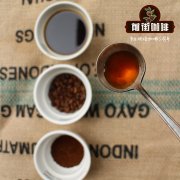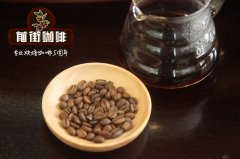How do I eat Starbucks coffee beans? How to eat coffee beans is the healthiest? Coffee bean brand recommendation

Professional coffee knowledge exchange more coffee bean information please follow the coffee workshop (Wechat official account cafe_style)
Some people like to drink coffee, and some foods, such as bread, will also add coffee beans to enhance the flavor. Some fans ask whether it will be harmful to health if they often eat roasted coffee beans without spitting out the coffee grounds. Doctors say that chewing coffee beans directly may consume too much caffeine, coffee grounds swallow, and it is easy to stimulate the stomach and intestines. It is recommended that coffee beans should not be eaten as a snack.
Doctors say that most people who drink coffee have side effects such as excessive excitement, palpitations and dizziness when they drink a few cups, but they may not be easy to handle if they eat a few coffee beans instead of coffee beans, so the risk of discomfort caused by excessive caffeine intake as a snack is higher than drinking coffee.
Eating coffee beans raw is not recommended.
The doctor also pointed out that if the coffee beans are chewed into coffee grounds in the mouth without spitting out, it will cause a burden on the stomach and intestines, because the coffee grounds are not easy to digest, and if they accumulate too much, they may block the intestines and cause constipation.
Other rules say that coffee dregs are not easy to digest, and that some people who are sensitive to the stomach and intestines may not be able to bear it, but may have diarrhea symptoms. At present, the medical community has no final conclusion on how many coffee beans can be eaten in a day, and it is recommended not to eat them raw.
Coffee is the most complex food in the known natural substances. Scientists have isolated more than 300 chemicals from raw coffee beans and more than 800 kinds of cooked beans, including many acidic organic compounds, which are not only the source of the sour flavor of caffeine. It is also a healthy antioxidant.
Among them, chlorogenic acid (chlorogenic acids) is the most abundant. Han Huaizong points out that chlorogenic acid is unflattering in taste buds and bitter in the mouth, but it has a strong ability of anti-oxidation and scavenging free radicals. Studies have found that chlorogenic acid can help the human body fight cancer. After baking, chlorogenic acid is decomposed into quinic acid (quinic acid) and caffeic acid, which also has antioxidant effect.
Coffee addicts agree that the most fragrant moment of ─ coffee is not when you drink it, but when you grind the beans and just cook them. The fragrance in the room makes people feel happy. This is the role of volatile antioxidants. The finer the ground beans and the more particles, the larger the total area of contact with the air, and the antioxidants will easily evaporate.
So, in order to reduce volatilization, can the intake of antioxidants be increased by grinding coffee beans to coarse particles? Han Huaizong, author of Coffee Science, disagrees. He believes that if these volatile antioxidants cannot be dissolved in water, they cannot be eaten even if they are left with more.
"only water-soluble antioxidants can be absorbed by the human body, and the finer the grinding, the higher the extraction rate, and the easier it is to dissolve organic acids and phenolic antioxidants," he suggests.
The International Coffee Organization has done a series of experiments to calculate the relationship between grinding fineness and acid aroma extraction concentration. Take chlorogenic acid as an example, under rough grinding, coffee beans can extract 700mg chlorogenic acid per liter, if fine grinding can increase the dissolution to 1065 mg per liter, if ultra-fine grinding coffee beans, chlorogenic acid can be as high as 1177 mg / L, 70% more than coarse particles.
Important Notice :
前街咖啡 FrontStreet Coffee has moved to new addredd:
FrontStreet Coffee Address: 315,Donghua East Road,GuangZhou
Tel:020 38364473
- Prev

Coffee bean Coffee beans how to eat Coffee beans in English
Professional coffee knowledge exchange more coffee bean information please pay attention to coffee workshop (Wechat official account cafe_style) coffee beans are the main raw materials for making coffee, as we all know, coffee has a refreshing effect after drinking, and many people will choose to make a cup of coffee to improve their work mood when they are very sleepy at work.
- Next

How to eat coffee beans best? Is it better to burn the coffee beans or lighter them?
Professional coffee knowledge exchange more coffee bean information Please follow the coffee workshop (Wechat official account cafe_style) after deciding whether to buy Ground coffee powder or whole coffee bean (Whole Bean) to be boiled before grinding, the next thing to choose is light roasting, medium roasting or deep roasting. Cyberian Cafe: Roast T
Related
- Guji coffee producing area of Guji, Ethiopia: Humbela, Shakiso, Wulaga
- What is the most expensive variety of Qiloso in BOP multi-variety group?
- How to store the coffee beans bought home?
- Why are Yemeni coffee beans so rare now?
- Ethiopian Sidamo all Red Fruit Sun Sun Santa Vini Coffee beans
- SOE is mostly sour? What does it mean? Is it a single bean? what's the difference between it and Italian blending?
- Is Italian coffee beans suitable for making hand-brewed coffee?
- How to choose coffee beans when making cold coffee? What kind of coffee beans are suitable for making cold coffee?
- Just entered the pit to make coffee, what kind of coffee beans should be chosen?
- Can only Japan buy real Blue Mountain Coffee? What are authentic Jamaican Blue Mountain coffee beans?

